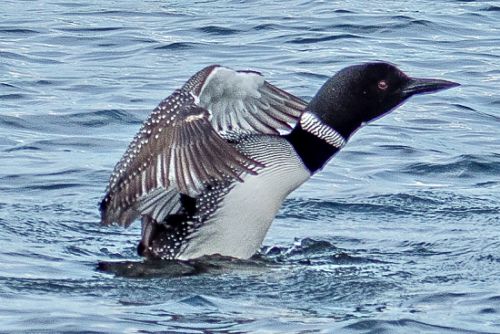
It Comes with the Territory

Last week, we were conducting a regular BLA Loon Survey on Great Pond when we saw a single loon behaving somewhat unusually. It was staying above the water more than normal and hugging the shore. We decided to check that area, the island off Foster Point, a little more thoroughly than usual.
The single loon began to follow us, which was intriguing because that behavior is typical of loons with a mate either on a nest or with a chick somewhere nearby. We’d never seen a loon nest over here, and we didn’t have this area recorded as a territory, so it wasn’t a regular part of our route. Surely enough, though, another adult was tucked into the safety of a little inlet, and to our surprise, it had a chick on its back! We happily recorded this observation under a brand new location, Foster Point Territory.

After five years into the Belgrade Lakes Association’s Loon Preservation Program, we’ve gotten a pretty good grasp of where loons like to nest, and where certain pairs can be found. Loons are territorial birds, defending an area ranging from a stretch of shoreline to the waters surrounding a small island to a cove or inlet. For instance, on Great Pond, territorial pairs can be found in the Marina (yes, really), on Oak, Pine and Blueberry Islands, and in the Robbins Mill Stream, to name a few. Territorial pairs will defend their home from intruding birds by posturing, yodeling, chasing them out, and sometimes, even fighting. We’ve found that the many of the most successful territories, or the ones that nest and subsequently hatch chicks, have few intrusions.
Because of the banding program, we can keep track of specific loons year to year. In most instances, territorial pairs will remain together in the same territory for numerous years, even reusing their nest. A common misconception, though, is that loons always mate for life. Especially here in the Belgrades, fidelity is often poor. Sometimes the incumbent female will nest with a new male, and sometimes it’s the other way around. Two new birds may even replace the old pair. While we are still learning why this happens, it’s part of the fascinating behavioral profile that makes loons so interesting to study.

As you explore the lake this summer, take a few minutes to stop and observe the loons. Over time, you may notice individual quirks: perhaps that certain birds dive frequently and slink low in the water, and that others are bold enough to swim right under your boat. Whether by bands or by distinctive size, try to line up all your observations with each other and even recognize individual birds. For instance, if you see a chick with its parents one week, the chances are good that it will be somewhere nearby the next time you see it. Loons’ territorial nature is one of their most unique and distinctive features, and like many other traits, it’s clear if you look closely. Happy birding!
A student at Colby College, Brynne Robbins is a summer intern with the Belgrade Lakes Association’s Loon Preservation Project. If you have questions regarding our Belgrade loon population, please email your inquiry to info@blamaine.org.
Download Full Newspaper: High Res | Low Res (Details…)
<— Previous Article • Summaries • Next Article —>
©2023 by Summertime in the Belgrades. All rights reserved.